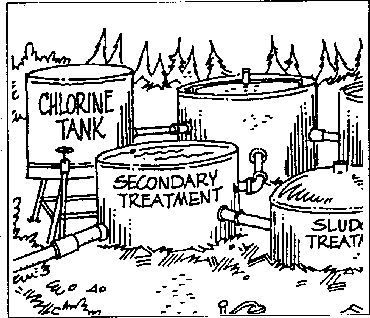|
What is water quality? To most
students, water quality may suggest
only "clean" water for drinking, swimming, and fishing.
But to the farmer or manufacturer, water quality may have an
entirely different meaning. One of the most important issues
concerning the quality of water is how that water will be used.
Water that is perfectly fine for irrigation might not be suitable
for drinking or swimming.
The quality of water can change as it flows over the land surface
as rivers, streams, lakes, or ponds (surface water), or under
the land surface (ground water). Because surface and ground waters
are interconnected in some areas, changes in the quality of surface
water can affect the quality of the area's ground water, and vice
versa. These changes in water quality may be due to natural factors
or human activities.
As rock minerals come in contact with water,
some dissolve and become part of the surface- or ground-water system. Other
natural
materials, such as soil or organic matter, become suspended in
the water and move from one place to another. The effects of
human activities on water may result from land disturbances, which
increase the amount of rock minerals, soils, or organic matter
available to be transported by and dissolved in water, or from
the addition of human-made pollutants. When water is degraded
to a point that affects its use for a particular purpose, it has
become polluted.
Water pollution originates from two very different
sources: point sources and nonpoint sources. This poster depicts human activities
associated with point sources (labeled in yellow) and nonpoint
sources (labeled in red). Also displayed is the movement of pollutants
from their sources to surface and ground waters. The stream flowing
from the mountains on the left-hand side of the poster represents
clean water not affected by human activities. The river on the
left-hand side of the poster receives pollutants from point sources
(wastewater treatment plant, storm drain, and factory). The quantities
of pollutants entering this river are reduced as a result of pollution-control
measures. The river on the right-hand side of the poster receives
pollutants from many nonpoint sources (suburban lawn, parking
lot, construction site, landfill, logging area, septic tank, and
agricultural field). This river receives large amounts of pollution
because there are no pollution controls. The bottom part of the
poster displays the movement of water between streams and the
underlying aquifer.
The poster is folded into 8.5" x 11" panels;
the front and back sides caneasily be photocopied.
Point-Source Pollution
 |
Pollution contributed
to water from a discrete source, such as
a pipe, ditch, tunnel, or well, are referred to as point sources.
Generally, pollution from point sources are controlled to some
degree by treatment technology. Municipal wastewater treatment
plants are one of the most common examples of treatment of point
sources. While a municipal wastewater treatment plant might receive
water from many sources, it discharges into a water body at a
single point. |
|

